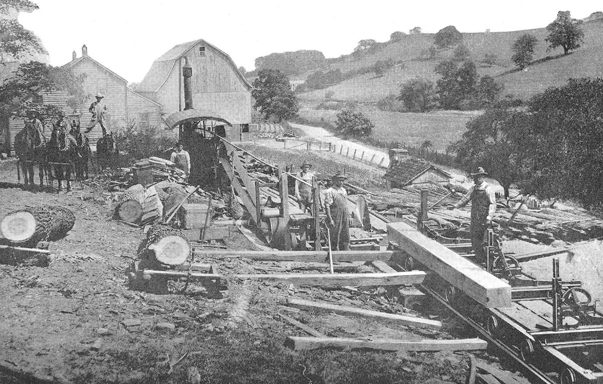About half a mile from the one-room school I attended was a saw mill that was owned by a farmer named Harvey Smith, and that was operated by Smith and his oldest son, Harold.
The saw mill itself was housed in a long, low shed made of rough-sawn boards and was powered by a large Minneapolis-Moline stationary gas engine that was painted bright prairie gold and sat outside the shed.
The Smith saw mill was permanently located and the local farmers had to haul their logs there to be cut into boards. Many saw mills, however, were portable and were hauled from place to place and set up near the source of the logs.

Memories shared
Here are some memories of one such mill as told by Frank Steele, who was born in 1900 and lived about three miles from where I grew up in South Beaver Township, Beaver County, Pennsylvania.
In the 1970s, Steel filled a loose leaf notebook with his handwritten recollections, a partial copy of which was given to me by my late cousin, Peg Townsend, who knew Mr. Steele.
Frank tells us that in 1913, when he was 13, his father decided to build a new barn and here is what he wrote in his own words, with only a few changes made for clarity.
* * *
“My father had William Weigle, a neighbor, to help saw down trees and cut them into logs for a new barn frame and other uses. One day Willis Bradshaw, a neighbor, was going to help. They had cut down a real large white oak tree over 30 inches in diameter and were sawing off a log with the cross cut saw.
“My father was driving an iron wedge in the cut and the sledge came off the handle and struck Mr. Bradshaw on the head and he dropped to the ground. My father put snow on his head to revive him and used his red handkerchief for a bandage and helped him walk to the house where my mother put on a white bandage and wanted to call a doctor. But he said ‘no’ and he got along OK.
“Some of the logs cut for the barn were 32 feet long. In the fall, my father and Forrest Cook went to Calcutta, Ohio, to see Bill Smith who had a saw mill to saw the logs. And one day in November ,Smith came with a Case steam traction engine pulling a wagon with the saw mill on it.
“In a couple of days Henry Smith walked from Calcutta. (Author’s note: Henry, Mr. Steele always spelled it “Henery” was Bill’s brother. The distance from the Steele farm to Calcutta, Ohio, was about 15 miles and Steele states that the brothers walked home every weekend).
“Henry had long hair down to his shoulders, a long black overcoat, and felt boots. They both looked like half Indians, six feet tall and raw-boned.
“They slept in our haymow until they built a shanty, as my mother would not leave them in the house. They built a shanty at the saw mill about 10 X 12 feet with a double deck bunk in one end. My father gave them straw for the bunks.
“They ate nothing but buckwheat cakes and sausage which my father sold them on credit for the sawing. They put baking powder and soda in the buckwheat cakes and they raised as high as the skillet, which they used instead of a griddle.
“Henry cut all the slabs by hand with a double-bitted ax to fire the boiler of the steam engine and the sparks would set fire to his long hair. He told me an ax was no plaything and to keep my hands off it.
“I hauled or drug the timbers for the barn frame and I also hauled sawn wagon tongues and planks into Beaver Falls in 1914 by myself. I was always afraid going down Steffen Hill with the horses and a loaded wagon.”
* * *
Hill was challenge
The town of Beaver Falls was about 8 miles from where Frank Steele lived and the Steffen Hill he referred to was a steep grade going down into the town with a railroad underpass and a sharp turn right at the foot.
When I was a kid, the hill was the accepted (at least among us teenagers) test of a car’s power: If your car could pull Steffen Hill in high gear, it was a good one (I didn’t have one that could). The hill was then (the late 1940s) also heavily used by large trucks and a runaway semi-truck would periodically be unable to make the turn at the bottom and would crash into one of the houses across from the underpass.
I’m sure there were losses of control and crashes of horse-drawn vehicles back in Steele’s time as well.
I wish Mr. Steele had described building of the barn, but I can find no other reference to it in his memoirs.
Still sawmills around
Sawmills are still very much in use (that’s where all those boards for sale in Lowe’s and Home Depot come from, just in case you wondered).
There was a portable mill just down the road from me last winter, and there are lots of permanent ones still in operation, especially in Holmes County.
I’ve never worked in a saw mill but I’m fascinated by them. Most of the tractor shows have an operating sawmill and I can spend a lot of time watching as the spinning blade reduces a log into usable lumber in no time.
The most elaborate mill I’ve seen is the Briden Roen steam saw mill at the Western Minnesota Steam Threshers Reunion in Rollag, Minnesota. This huge mill is powered by a Case 110 H.P. skid steam engine and several smaller units, including one that hoists the logs into the mill.
If you ever get a chance to see it, don’t miss it.












